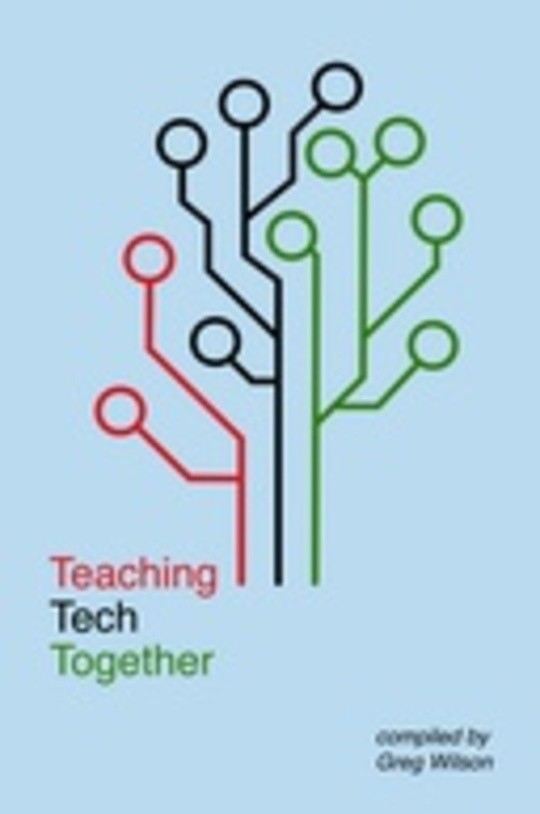
Teaching Tech Together
Free
Description
Contents
Reviews
Language
English
ISBN
0262018063
Teaching Tech Together
Introduction
1.1) Who You Are
1.2) What to Read Instead
1.3) History
1.4) Why Learn to Program?
1.5) Have a Code of Conduct
1.6) Acknowledgments
1.7) Exercises
Building Mental Models
2.1) Are People Learning?
2.2) Exercises
Expertise and Memory
3.1) Concept Maps
3.2) Seven Plus or Minus Two
3.3) Pattern Recognition
3.4) Becoming an Expert
3.5) Exercises
Cognitive Load
4.1) Split Attention
4.2) Minimal Manuals
4.3) Exercises
Individual Learning
5.1) Six Strategies
5.2) Time Management
5.3) Peer Assessment
5.4) Exercises
A Lesson Design Process
6.1) Learner Personas
6.2) Learning Objectives
6.3) Maintainability
6.4) Exercises
Actionable Approximations of the Truth
7.1) How Do Novices Program?
7.2) How Do Novices Debug and Test?
7.3) What Misconceptions Do Novices Have?
7.4) What Mistakes Do Novices Make?
7.5) What Are We Teaching Them Now?
7.6) Do Languages Matter?
7.7) Does Better Feedback Help?
7.8) What Else Can We Do to Help?
7.9) Exercises
Teaching as a Performance Art
8.1) Lesson Study
8.2) Giving and Getting Feedback on Teaching
8.3) How to Practice Performance
8.4) Live Coding
8.5) Exercises
In the Classroom
9.1) Enforce the Code of Conduct
9.2) Peer Instruction
9.3) Teach Together
9.4) Assess Prior Knowledge
9.5) Plan for Mixed Abilities
9.6) Pair Programming
9.7) Take Notes…Together?
9.8) Sticky Notes
9.9) Never a Blank Page
9.10) Setting Up Your Learners
9.11) Other Teaching Practices
9.12) Limit Innovation
9.13) Exercises
Motivation and Demotivation
10.1) Authentic Tasks
10.2) Demotivation
10.3) Accessibility
10.4) Inclusivity
10.5) Exercises
Teaching Online
11.1) MOOCs
11.2) Video
11.3) Flipped Classrooms
11.4) Life Online
11.5) Exercises
Exercise Types
12.1) The Classics
12.2) Tracing
12.3) Diagrams
12.4) Automatic Grading
12.5) Higher-Level Thinking
12.6) Exercises
Building Community
13.1) Learn, Then Do
13.2) Three Steps
13.3) Retention
13.4) Governance
13.5) Final Thoughts
13.6) Exercises
Marketing
14.1) What Are You Offering to Whom?
14.2) Branding and Positioning
14.3) The Art of the Cold Call
14.4) A Final Thought
14.5) Exercises
Partnerships
15.1) Working With Schools
15.2) Working Outside Schools
15.3) Final Thoughts
15.4) Exercises
Why I Teach
Bibliography
License
Citation
Joining Our Community
C.1) Contributor Covenant
C.2) Using This Material
C.3) Contributing and Maintaining
Code of Conduct
Glossary
Meetings, Meetings, Meetings
Online Meetings
The Post Mortem
A Little Bit of Theory
Notional Machines
Lesson Design Template
Step 1: Brainstorming
Step 2: Who Is This Course For?
Step 3: What Will Learners Do Along the Way?
Step 4: How Are Concepts Connected?
Step 5: Course Overview
Reminder
Checklists for Events
Scheduling the Event
Setting Up
At the Start of the Event
At the End of the Event
Travel Kit
Presentation Rubric
Teamwork Rubric
Pre-Assessment Questionnaire
Design Notes
Brainstorming
Intended Audience
Exercises
Outline
Course Overview
The book hasn't received reviews yet.











